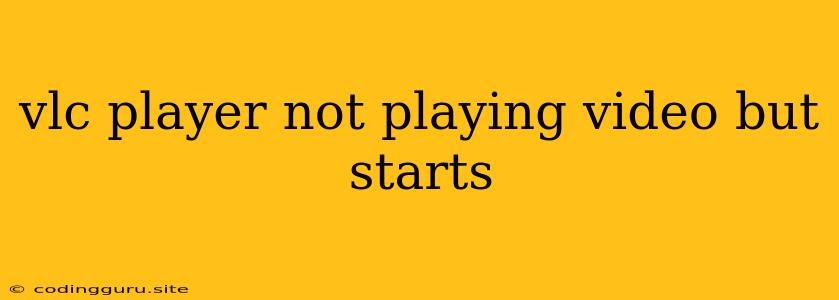Why Is VLC Player Not Playing Videos But Starts?
The VLC media player is a popular and versatile tool for watching videos on your computer. However, sometimes you might encounter a frustrating situation where VLC starts but doesn't play any video. This can be caused by several factors, and troubleshooting the issue requires identifying the root cause. This article will guide you through some common reasons why VLC player might not be playing videos and offer solutions to get your videos running smoothly again.
Common Reasons Why VLC Might Not Play Videos
Here are some of the most frequent reasons why VLC might be failing to play your videos:
- Incorrect Video Format: VLC is known for its extensive codec support, but it might not be able to play every single video format. If VLC starts but doesn't play your video, it could be that the video file is in an unsupported format.
- Corrupted Video File: Damaged or corrupted video files can prevent VLC from playing them. This could happen due to interruptions during download, errors during transfer, or even file system problems.
- Missing or Outdated Codecs: VLC relies on codecs to decode and play video files. If the required codecs are missing or outdated, you might encounter playback issues.
- Hardware Acceleration Problems: VLC utilizes hardware acceleration to improve playback performance, but sometimes this feature can cause problems. Disabling hardware acceleration might resolve certain playback issues.
- Incorrect VLC Settings: VLC has a wide range of settings that can impact its functionality. If certain settings are not configured correctly, they might prevent video playback.
- Outdated VLC Version: Using an outdated version of VLC might lead to compatibility issues and prevent certain videos from playing properly. Keeping your VLC player updated is essential for optimal performance.
- Conflicting Software: Certain software on your computer, like antivirus or other media players, could interfere with VLC's operation and prevent videos from playing.
- System Resources Issues: Insufficient system resources like RAM or CPU power might cause VLC to struggle to play videos smoothly.
Troubleshooting Tips:
1. Check Video Format Compatibility:
- Identify the video file format: Right-click on the video file and select "Properties." Look for the "File type" or "Type of file" information to determine the format.
- Verify VLC compatibility: Consult VLC's official documentation or websites like to confirm if VLC supports the video format.
- Convert video format: If your video file is in an unsupported format, consider converting it to a compatible format using a dedicated video converter tool.
2. Check for Video File Corruption:
- Try opening the video file with another media player: If another media player can play the video file without issues, this confirms that the video file itself is not corrupt.
- Repair or recover the video file: If the video file is corrupted, try using dedicated file repair software to recover it.
3. Update VLC Codecs:
- Check VLC settings for codec updates: VLC usually updates its codecs automatically, but you can manually check for updates in the "Tools" > "Preferences" menu.
- Install missing codecs: If VLC is missing certain codecs, you can download and install them from reputable sources. Websites like offer a wide selection of codecs.
4. Disable Hardware Acceleration:
- Access VLC settings: Open VLC and navigate to "Tools" > "Preferences."
- Locate "Input / Codecs" section: In the settings menu, click on "Input / Codecs" under the "Show settings" drop-down menu.
- Disable "Hardware acceleration decoding" option: Uncheck the box next to "Hardware accelerated decoding" under the "Deinterlacing" option.
5. Adjust VLC Settings:
- Check output settings: Ensure that the output settings are correct for your audio and video devices. You can access output settings in "Tools" > "Preferences" > "Audio / Video" section.
- Disable subtitles: If subtitles are causing problems, disable them in the "Subtitle" settings.
- Reset VLC to default settings: Resetting VLC to its default configuration might resolve issues caused by incorrect settings.
6. Update VLC Player:
- Check for VLC updates: Open VLC and visit "Help" > "Check for updates" to see if a newer version is available.
- Download and install the latest version: If a newer version is available, download and install it from the official VLC website.
7. Check for Conflicting Software:
- Temporarily disable antivirus software: Disable your antivirus temporarily to check if it is interfering with VLC.
- Close other media players: Ensure that no other media players are running in the background.
8. Verify System Resources:
- Check system memory and CPU usage: Monitor your system resources to see if VLC is consuming too much memory or CPU power. Close other applications that might be using excessive resources.
- Upgrade system memory: If your system is consistently running low on RAM, consider upgrading your system memory to ensure enough resources for VLC to run smoothly.
9. Reinstall VLC:
- Uninstall VLC completely: Remove VLC from your computer using the control panel's "Uninstall a program" option.
- Download and install VLC again: Download the latest version of VLC from the official website and install it fresh.
Conclusion
Troubleshooting why VLC player is not playing videos but starts can be frustrating, but by following these tips and understanding the potential causes, you can effectively identify the root issue and resolve it. It's crucial to check video format compatibility, verify file integrity, update codecs, adjust VLC settings, and consider system resource availability. If all else fails, reinstalling VLC can sometimes resolve the issue. Remember to keep your VLC player updated and be aware of potential conflicts with other software to avoid future playback problems.
